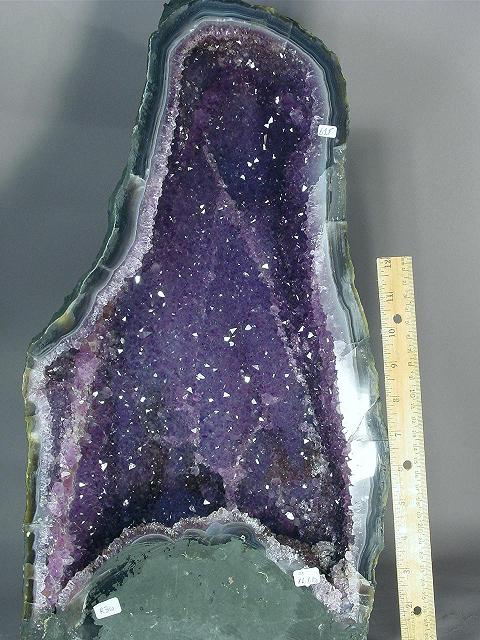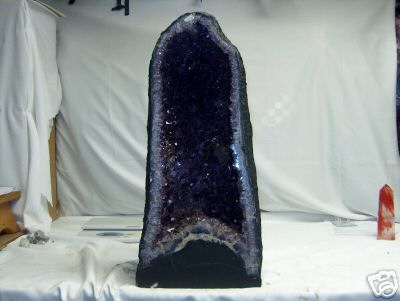
Durango Bill’s
Geodes
Amethyst Cathedrals
Geodes and in
particular amethyst geodes are fascinating members of the
quartz-crystal family. Tall purple/violet geodes are usually
called amethyst cathedrals.

The amethyst cathedral above is
one of the specimens in the author’s collection and was
purchased from Geosol Imports. http://www.buygeodes.com/geodes/index.html
 The
picture at the right is another amethyst cathedral in the
author’s “indoor rock garden”. This one was purchased from
geodes_etc. (http://stores.ebay.com/geodes-etc
- an eBay store) The two amethyst cathedrals now have a
place of honor on the top shelf of an entertainment center.
(Both are nearly two feet tall.)
The
picture at the right is another amethyst cathedral in the
author’s “indoor rock garden”. This one was purchased from
geodes_etc. (http://stores.ebay.com/geodes-etc
- an eBay store) The two amethyst cathedrals now have a
place of honor on the top shelf of an entertainment center.
(Both are nearly two feet tall.)
Water vapor is a major component of the dissolved gases. As the rock cools, water vapor gradually condenses to become very hot water. Hot water can dissolve many minerals including silicon dioxide. The hot water with its high concentration of dissolved silicon dioxide is squeezed into the bubble cavities. As the rock slowly cools, the silicon dioxide crystallizes to form quartz crystals on the inside walls of the “bubble”, and gradually starts transforming it into a geode.
Hot ground water also contributes as it percolates upward through the rock, and then through cracks in the geode, to deposit more silicon dioxide in the growing quartz crystals. The ground water is hottest at lower depths and then cools as it rises closer to the surface. Cooler water can not hold as much dissolved material, hence the quartz crystallizes out. Also, the dissolved gases have to contain high concentrations of carbon dioxide if quartz crystals are to form.
Iron is also dissolved by hot water to form iron oxides. When dissolved iron impurities are present when the quartz crystals are forming, they produce a purple/violet color. As crystals grow inward from the edge of a geode, the silicon dioxide tends to come out of solution first. This concentrates the dissolved iron in the remaining liquid in the “bubble”. As the iron solution becomes more concentrated, it eventually also comes out of solution to be incorporated in the quartz crystals. Hence the purple/violet color becomes more intense in the tips of the crystals. Trace amounts of other impurities may also be present in amethyst geodes, but the purple/violet color is produced by iron.
The purple/violet color of amethyst crystals is also sensitive to temperature. Water temperatures must be between 90 and 250 degrees C. Above 250 degrees the violet color starts disappearing. At higher temperatures (e.g. 400 to 700 degrees), the iron impurities will produce a yellow/citrine color. Dealers will sometimes heat an amethyst geode to this higher temperature to artificially create a “Citrine” geode.
Return to Durango Bill’s home page
Web page generated via Sea Monkey's Composer HTML editor
within a Linux Cinnamon Mint 18 operating system.
(Goodbye Microsoft)